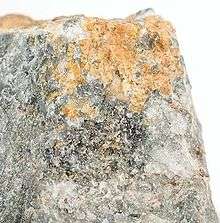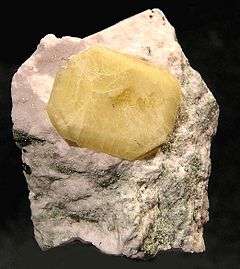Narsarsukite
| Narsarsukite | |
|---|---|
|
1.3 cm crystal of narsarsukite from Mont Saint-Hilaire | |
| General | |
| Category | Silicate mineral |
| Formula (repeating unit) | Na4(Ti,Fe)4[Si8O20](O,OH,F)4.[1] |
| Strunz classification | 9.DJ.05 |
| Crystal system | Tetragonal |
| Crystal class |
Dipyramidal (4/m) H-M symbol: (4/m) |
| Space group | I4/m |
| Unit cell | a = 10.72, c = 7.95 [Å]; Z = 4 |
| Identification | |
| Color | Honey to lemon-yellow, reddish brown, brownish gray, tan, pink; may be green from inclusions; may show color zoning |
| Crystal habit | Occurs as flat tabular to equant, striated crystals In divergent, radiating groups; massive |
| Cleavage | Good on {100} and {110} |
| Fracture | Uneven to subconchoidal |
| Tenacity | Brittle |
| Mohs scale hardness | 5.5 - 7 |
| Luster | Vitreous, pearly on {110} |
| Streak | White |
| Diaphaneity | Transparent to translucent |
| Specific gravity | 2.64-2.83 |
| Optical properties | Uniaxial (+) |
| Refractive index | nω = 1.609 nε = 1.630 |
| Birefringence | δ = 0.021 |
| Pleochroism | Weak; O = colorless to yellow; E = colorless to honey-yellow |
| References | [2][1][3] |
Narsarsukite is a rare silicate mineral with chemical formula Na2(Ti,Fe3+)Si4(O,F)11[2] or Na4(Ti,Fe)4[Si8O20](O,OH,F)4.[1]
It was first described in 1900 for an occurrence in the Narsarsuk pegmatite in the Ilimaussaq intrusive complex of West Greenland.[1] It has also been reported from a syenite which intruded limestone in the Sweetgrass Hills, Montana, and within hornfels and marble xenoliths in the alkalic intrusive of Mont Saint-Hilaire, Quebec.[2] It occurs associated with aegirine, microcline, albite, elpidite, epididymite, taeniolite, pectolite, calcite, galena and quartz.[2]

Narsarsukite from Whitlash, Liberty County, Montana {size: 5.6 x 5.4 x 5.1 cm)
References
This article is issued from Wikipedia - version of the 11/4/2016. The text is available under the Creative Commons Attribution/Share Alike but additional terms may apply for the media files.
